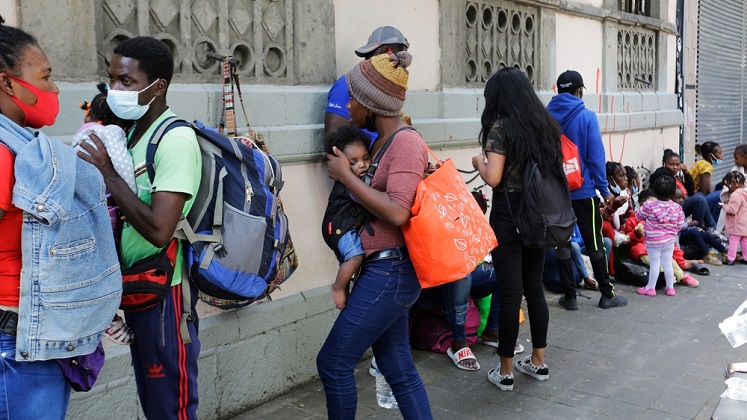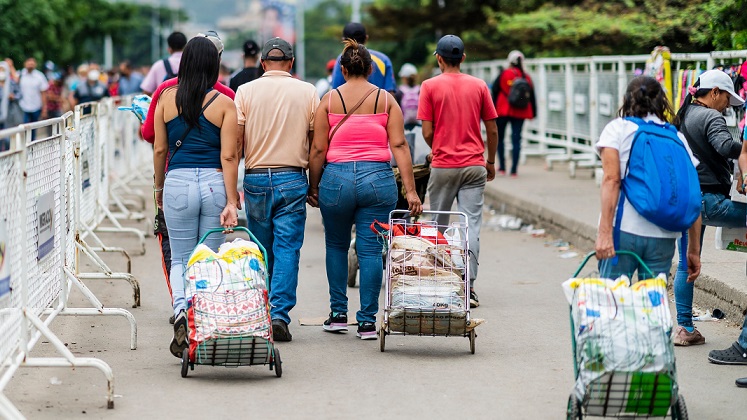Forced migration is on the rise globally. People flee their homes due to conflict, climate change and violence. The death of 53 people from Mexico, Guatemala, Honduras and El Salvador inside a truck in June is one of the deadliest cases of human smuggling across the US border with Mexico. In the documentary The Vertical Border, Sonja Wolf (LSE Latin America and Caribbean Centre, and Centre for Economic Teaching and Research, Mexico) explores the dangers of migrating and the lack of alternatives for those who try their luck.
Lea este artículo en español
“Do not come. Do not come.” With these words, uttered during a press conference in Guatemala City in June 2021, US Vice President Kamala Harris warned Central American migrants that they would be turned back if they tried entering the United States without authorisation. Harris’s remarks open my 2022 feature documentary, The Vertical Border, co-produced by the CIDE’s Drug Policy Programme and the refugee integration group Habesha, both located in Aguascalientes, Mexico.
Travelling from northern Central America to the US-Mexico border, the film examines why people become forced migrants and why transit and destination countries often give them a hostile welcome. “Forced migrants” is the term I chose to refer to all those, including internally displaced persons, refugees, and asylum seekers, who are uprooted from their homes and perceive no alternative to migration.
If we shift our gaze away from the Americas for a moment, what do we see? We see, for example, how Russia’s invasion of Ukraine quickly displaced the humanitarian disaster in post-US withdrawal Afghanistan from the international news agenda. The conflict in Europe has prompted an outpouring of solidarity with Ukrainian refugees. But it also sparked controversial initiatives, such as the Boris Johnson government’s ill-devised sponsorship scheme Homes for Ukraine. The British Home Office’s impractical plan to take asylum seekers from the UK to Rwanda to claim their refugee status there instead of processing it in Britain caused widespread indignation.
These displacement situations, and their responses, may seem worlds away from the plight of Central Americans that The Vertical Border narrates. But all these stories shine a light on three things.
On the one hand, food insecurity, the effects of climate change, gender-based violence, and armed violence are the drivers or root causes of forced migration. On the other, the patterns of displacement occur within or across borders and continents. And finally, the policies of transit and destination countries often contribute to the perils and protracted nature of forced migration.
Transit states like Mexico, are clogged between the nations expelling migrants and those receiving them. With a limited capacity to care for displaced persons, transit countries may still become involuntary hosts to large numbers of migrants who are unable to continue their journey.
Destination countries like the United States, offer new chances and opportunities but fail at admitting individuals who are poor or come from unfamiliar cultural or religious backgrounds. The same nations that turn away oppressed people also “externalise” or push out their borders. Using financial incentives or diplomatic and commercial pressures, they ask their neighbours to intercept and deport forced migrants.

Migration limbo
Governments make the following arguments to lend their deterrence strategies an aura of legitimacy. One of them is defining those who undertake a clandestine journey as merely economic migrants –people chasing some version of the “American Dream”, not fleeing structural and physical violence. This labelling allows governments to avoid their obligations to provide humanitarian assistance and international protection. The other is bringing up the inherent dangers of irregular migration. It may involve a passage in a rubber dinghy or a long foot march through a desert, and unscrupulous smugglers make it only more treacherous. Deterrence is just a way to crack down on an industry that profits by encouraging people to break the law.
But these arguments miss a point. If displaced persons could get visas, they would not need to risk their lives in a bid to survive. Smugglers may make money off desperate migrants, and the demand for their services grows while wealthy nations try to close their borders to people with the “wrong” passport. People from poor nations are being systematically excluded – through onerous visa policies and other deterrence strategies.
This sums up the migration policy status quo we are stuck in. Ravaged by global capitalism and climate change, the world is in crisis. UNHCR data indicates that the number of individuals in forced displacement increases yearly, reaching 89.3 million at the end of 2021. Despite this trend, we are no closer to addressing migration motives or to offering viable alternatives to people who struggle to build a sustainable livelihood.
Colonialism and imperialism have worsened living conditions in the Global South. Yet, when people seek to escape exploitative conditions, the countries of the Global North often deny them a dignified existence. How, then, can we move towards the implementation of human rights-based migration policies?
The need for a different storytelling
The Vertical Border builds on my earlier research that examined, through in-depth interviews with Central American forced migrants in Mexico, how they had negotiated violence before, during, and after displacement. This project produced analytical reports, testimonial collections, and podcasts narrating migrants’ lived experiences.
The film goes a step further and aims to be a piece of visual storytelling that can reach wider audiences. This independent documentary wants to speak directly to citizens, building their empathy and understanding for migrants, and inviting them to reflect on how they might create more welcoming communities. The Vertical Border is a tool to generate bottom-up pressure for migration policy change by trying to shape the policy environment, rather than policymaking.
Academic publications are often inaccessible to most members of the public because they often speak to a small intellectual audience. They may get translated into recommendations for governments. Still, competing priorities, resource constraints, institutional habits, and clinging to short-term solutions can hamper the implementation of even the most convincing and empirically sustained proposals. If scientific research is to produce tangible policy outcomes and social transformations, then we need to rethink how and to whom we tell our stories. In this sense, The Vertical Border also serves as an invitation for academics to package their findings in ways that are both educational and engaging.

Re-imagining the world
Making the documentary required a balancing of cinematography, ethics, and safety. The narrative was meant to be aesthetically compelling, but it had to avoid jeopardising the safety of the participants and filmmakers. Access restrictions called for the use of animation and archival footage instead of location shooting. Gang violence is one of the main drivers of forced migration from El Salvador and Honduras. Given the pervasive climate of fear in gang-affected communities, its impact was one of the most complex things to film.
There is a growing interest in making both research and the arts more inclusive. How can we take a deep dive into social issues and convey, in a feasible way yet feels nuanced, authentic, and absorbing, everyday injustices, everyday struggles of survival, and everyday acts of resistance? What relationships do we need to cultivate to make silenced voices heard? What time and funding does this work demand?
Producing the film reminded me that academics have much to gain not only from using visual storytelling but also from collaborating with the creative industries. Research-informed artistic initiatives are immensely valuable in inspiring a more meaningful public debate and engagement. Ultimately, they can help hold governments accountable for their hostile migration policies.
The Vertical Border ends with Todd Miller, a renowned writer and long-time Arizona resident, urging us to think of the world with a global consciousness. Some viewers may find his reflections utopian. But while more and more people suffer from economic and environmental inequalities, it is inevitable imagining a radically different world, one that is liveable for everyone and not just for a privileged minority. The Vertical Border is part of this process of rekindling our imagination.
Notes:
• The views expressed here are of the author rather than the Centre or the LSE
• Please read our Comments Policy before commenting
• Banner image: Nogales border wall from the United States side / Peg Hunter (CC BY-NC 2.0)






How many should be allowed to cross the border from a particular country, before the tax payers of the destination countries respond by saying yes, happy to recognise you’re coming from a failed state, happy also to open the border, as long as we can now take over governance of your failed state in exchange to fund this. For open borders to work, we have to make sure we’re taking over management of the governments of sending countries (the failed states that can’t offer protection to their people), so the flow can go both ways and there’s a benefit for both sides.